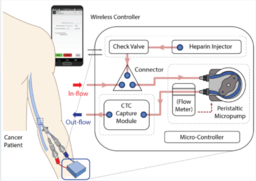Microfluidic Flow Control using Direct-Current Peristaltic Pump
TECHNOLOGY NUMBER: 2020-236

OVERVIEW
Cell focusing device and pump control system for circulating tumor cell (CTC) capture- A wearable 'watch'-like microfluidic system to capture CTCs in real-time
- Collects larger sample volumes over time to yield higher CTC yield and improved diagnosis
BACKGROUND
Technological advances have piqued an interest in the optimal ways to identify circulating tumor cells (CTCs) via a liquid biopsy of patient serum. CTCs are a rare subset of cells found in the blood of patients with solid tumors that may be destroyed by the body's immune system or end up seeding metastatic sites. The ability to separate CTCs from blood can diagnose cancer, delineate prognosis, and provide a guide for treatment. The exceedingly low concentration of CTCs in blood makes it difficult for existing techniques to identify those cells. The use and application of microfluidic devices has grown greatly over the past decades and offers hope in setting. Microfluidic devices allow for the miniaturization of complex fluid manipulation in small, inexpensive packages. As a result, many microfluidic devices have been presented as lower cost and smaller in size alternatives to more common laboratory analytical equipment. Still, a need exists to overcome some of the limitations of existing microfluidic systems to measure CTCs more efficiently in patient serum.
INNOVATION
Researchers at the University of Michigan have invented a cell focusing device and pump control system for circulating tumor cell (CTC) capture. The mechanism allows the patient to use a wearable "watch"-like device to capture CTCs in real-time. This approach collects larger sample volumes over time than a simple blood draw to yield higher CTC yield and improved diagnosis. The invention can model and control pressure at the inlet of a microfluidic lab-on-a-chip (LOC) device using simple peristaltic pump and sensing components. The pump is capable of compensating for varying resistance of the LOC device caused by changes in the density and viscosity of blood. This novel approach shows promise in detecting CTCs, and future modifications of the system architecture and associated model will permit more sophisticated viscosity identification and control designs for designs for increasingly accurate measures.